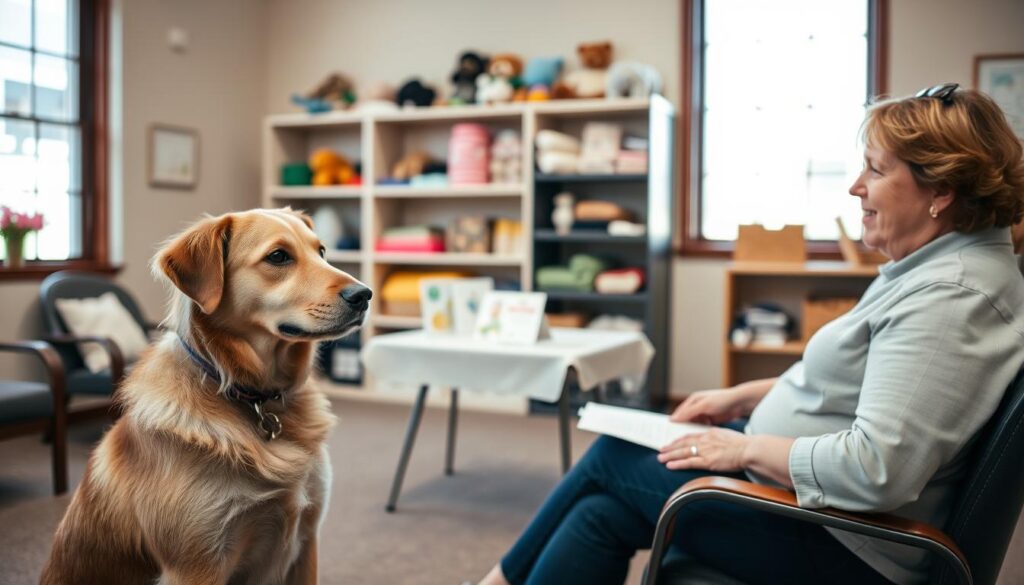Our journey with therapy dogs has been incredibly rewarding. We’ve seen firsthand the positive impact these special dogs can have on people’s lives.
As we share our experience, we’ll explore what makes a therapy dog different from other types of support animals, such as emotional support animals. We’ll also discuss the growing popularity of therapy programs in various settings.
Before bringing a dog into your home as a therapy animal, it’s essential to understand the certification process and the responsibilities that come with it.
Key Takeaways
- Understanding the role of therapy dogs and their differences from other support animals.
- The importance of certification for therapy dogs.
- Key considerations before deciding to bring a therapy dog into your home.
- The impact of therapy dogs on various settings such as hospitals and schools.
- The responsibilities and rewards of owning a therapy dog.
Understanding Therapy Dogs
As part of a broader animal-assisted therapy approach, therapy dogs play a crucial role in enhancing the well-being of humans. Therapy dogs are trained to provide affection, comfort, and emotional support to people in various settings, including hospitals, nursing homes, and schools.
What Is a Therapy Dog?
A therapy dog is a dog that is trained to provide emotional support and comfort to people in need. These dogs are often used in therapy settings to help individuals cope with stress, anxiety, and other emotional challenges. “Therapy dogs are a great source of comfort and joy,” says a renowned animal therapist. Unlike service dogs, therapy dogs are not trained to perform specific tasks for individuals with disabilities.
Therapy Dogs vs. Service Dogs vs. Facility Dogs
It’s essential to distinguish between therapy dogs, service dogs, and facility dogs. While service dogs are trained to assist individuals with disabilities, therapy dogs are trained to provide emotional support to people in various settings. Facility dogs, on the other hand, are often used in specific facilities, such as hospitals or nursing homes, to provide comfort and support to residents or patients.
Benefits of Therapy Dogs
The benefits of therapy dogs are numerous. Interacting with therapy dogs has been shown to reduce stress hormones, lower blood pressure, and decrease anxiety in humans. Therapy dogs can also help improve mood, increase socialization, and provide emotional support for people in need. As studies have demonstrated, the presence of therapy dogs can have a positive impact on both humans and dogs, promoting overall well-being.
The advantages of therapy dogs extend to various populations, including children with reading difficulties, individuals experiencing trauma or grief, and patients undergoing physical therapy. By providing a non-judgmental audience and motivation, therapy dogs can facilitate therapeutic progress and enhance the overall therapy experience.
Our Journey to Adopt a Therapy Dog
Our path to adopting a therapy dog was filled with research, anticipation, and a deep desire to make a difference. As we navigated this journey, we learned valuable lessons that we believe will be beneficial to others considering the same path.
Why We Decided to Adopt a Therapy Dog
We decided to adopt a therapy dog after understanding the profound impact they have on people’s lives. Therapy dogs provide comfort, companionship, and emotional support to individuals in various settings, such as hospitals, nursing homes, and schools. Our decision was driven by a desire to be part of this positive impact.
The benefits of therapy dogs are multifaceted. Not only do they bring joy and comfort to those they visit, but they also provide an opportunity for social interaction and emotional healing. We were drawn to the idea of being able to make a difference in our community through this unique role.
Initial Research and Considerations
Before starting the adoption process, we conducted extensive research on what it means to be a therapy dog owner. This included understanding the training requirements, the time commitment involved, and the characteristics of a dog suitable for therapy work.
- Understanding the role of a therapy dog and the settings in which they work.
- Researching reputable organizations that facilitate therapy dog adoption.
- Learning about the certification process and ongoing training needs.
Setting Realistic Expectations
Setting realistic expectations was crucial in our journey. We learned that not every dog is suited for therapy work, regardless of the training they receive. It’s essential to understand that the process takes time and that patience is key during the certification process and beyond.
We also prepared ourselves for the emotional aspects of therapy work. While it can be incredibly rewarding, it also comes with its challenges. Understanding this balance helped us approach our decision with a clear and level head.
Finding the Right Therapy Dog
The process of finding a suitable therapy dog can be both exciting and overwhelming, given the numerous options available. When searching for a therapy dog, it’s essential to consider various factors, including breed, temperament, and the source of adoption.
Breeds Commonly Used as Therapy Dogs
While any dog can potentially become a therapy dog with the right temperament, some breeds are more commonly associated with this role due to their calm and affectionate nature. Breeds like Labrador Retrievers, Golden Retrievers, and Cavalier King Charles Spaniels are popular choices for therapy work because of their gentle disposition and ability to form strong bonds with people.
Temperament and Characteristics to Look For
Beyond breed, the temperament and characteristics of a dog are crucial in determining its suitability as a therapy dog. A good therapy dog should be calm, patient, and enjoy human interaction. They should also be comfortable in a variety of environments and around different types of people. Socialization is key, and dogs that are well-socialized from an early age tend to make excellent therapy dogs.
When evaluating a dog’s potential for therapy work, we look for dogs that are not easily startled, are comfortable with being touched, and can remain calm in potentially stressful situations. These characteristics, combined with proper training, make a dog an excellent canine companion for therapy.
Where to Adopt a Therapy Dog
There are several avenues to explore when looking to adopt a therapy dog. Specialized organizations like Canine Companions offer programs for dogs that have been released from their initial training or are otherwise suitable for therapy work. Additionally, many dogs in shelters and rescues have the potential to become wonderful therapy dogs with the right training and socialization.
Working with reputable breeders who focus on breeding dogs with temperament traits suitable for therapy work is another option. Some therapy dog organizations also have their own breeding programs aimed at producing dogs with the ideal characteristics for therapy work. Whether to adopt an adult dog or a puppy depends on several factors, including your experience, the amount of time you have for training, and your personal preferences.
The Adoption Process
Adopting a therapy dog is a rewarding experience that requires careful consideration and a thorough understanding of the adoption process. This process is designed to match dogs with suitable owners, ensuring the well-being of both the dog and the adoptive family.
Application Requirements
The first step in adopting a therapy dog is to submit an application. This typically involves providing detailed information about your lifestyle, experience with dogs, and the environment you can offer to a therapy dog. Organizations often look for adopters who can provide a stable and loving home. The application process helps organizations assess whether you’re a good fit for a therapy dog.
Costs and Fees
Adopting a therapy dog often comes with associated costs and fees. These can include application fees, adoption fees, and costs for training and equipment. It’s essential to understand these expenses to ensure you can provide the necessary care and support for your dog.
The Waiting Period
After submitting your application, there’s typically a waiting period. This can range from several months to a few years, depending on the organization’s matching process and the availability of dogs. It’s crucial to be patient and maintain communication with the adoption organization during this time. We found that staying informed and being flexible helped us navigate this period successfully.

During the waiting period, it’s beneficial to prepare yourself and your home for the arrival of your therapy dog. This includes learning about therapy dog training, understanding the needs of therapy dogs, and making necessary adjustments to your home environment.
Organizations That Provide Therapy Dogs
The journey to adopting a therapy dog often begins with researching reputable organizations. These organizations not only provide therapy dogs but also offer training, certification, and support to ensure that both the dog and handler are prepared for their role.
Canine Companions Program

The Canine Companions Therapy Dog Certification Program is a well-respected program recognized by the American Kennel Club (AKC). Teams certified through this program are eligible to receive AKC Therapy Dog titles, further validating their hard work and dedication. The program focuses on providing highly trained dogs to individuals in need, enhancing their ability to provide comfort and support.
Other Reputable Organizations
Besides the Canine Companions Program, several other organizations provide therapy dogs or therapy dog certification across the United States. The Alliance of Therapy Dogs is a national organization that offers certification, registration, support, and insurance for therapy dog teams. Pet Partners, formerly known as Delta Society, is another prominent organization, recognized as one of the largest therapy animal organizations in the country. Therapy Dogs International (TDI) is also noteworthy for its rigorous testing and certification processes.
Local therapy dog groups often partner with these national organizations to provide training and support, ensuring a comprehensive approach to therapy dog work. When choosing an organization, it’s essential to compare their requirements, geographic coverage, and specialties to find the best fit for your situation.
Preparing Your Home for a Therapy Dog
Welcoming a therapy dog into your home requires careful preparation to ensure a smooth transition for both the dog and your family. As we’ve experienced firsthand, it’s not just about providing a loving home but also about creating an environment that supports the dog’s role as a therapy animal.
Essential Supplies and Equipment
To start, you’ll need to stock up on essential supplies. These include a comfortable dog bed, nutritious food, and appropriate toys. Investing in a good quality crate can also be beneficial for training and providing a safe space for your dog. “A well-prepared home is the foundation of a happy and healthy therapy dog,” as many trainers emphasize.
Creating a Safe and Comfortable Space
Creating a safe and comfortable space for your therapy dog involves dog-proofing your home and designating areas where your dog can relax and play. This might mean securing toxic substances out of reach and setting up a quiet area for your dog to retreat to when needed.
Introducing Your New Dog to Family Members and Other Pets
When introducing your new therapy dog to family members and other pets, it’s crucial to do so gradually and under controlled circumstances. We found that supervising initial interactions and rewarding calm behavior helped create positive associations. As one expert notes, “A smooth introduction is key to a harmonious household.”
By following these steps and being mindful of your dog’s needs, you can create a welcoming and supportive environment that allows your therapy dog to thrive.
Training Your Therapy Dog
Effective training is the cornerstone of a successful therapy dog program, and we’re excited to share our insights. As we reflect on our journey, it’s clear that comprehensive training was crucial in preparing our dog for the vital role they play.
Basic Obedience Training
Basic obedience training lays the foundation for a well-behaved dog. This includes teaching fundamental commands like “sit,” “stay,” and “walk on a leash.” Our dog learned these skills during the initial stages of training, which helped in developing a strong bond between us and our therapy dog.
Specialized Therapy Dog Training
Once the basic obedience skills were mastered, our dog underwent therapy dog training. This specialized training is designed to prepare dogs for the unique environments and situations they’ll encounter during therapy visits. It includes exposure to various settings, people, and experiences to ensure our dog remains calm and composed.
All Canine Companions dogs spend their first 16 to 18 months with volunteer puppy raisers who provide socialization and basic training, including leash manners and crate training. This early training is invaluable in shaping their behavior and temperament.
Working with Professional Trainers
Working with professional trainers who specialize in therapy dog preparation was a game-changer for us. These experts helped us identify areas for improvement and provided tailored guidance to address the specific needs of our dog and handler team. They emphasized the importance of the handler‘s role in the training process.
When searching for “therapy dog trainers near me,” we found that local trainers with experience in therapy dog work were invaluable. They offered group classes and private training sessions, each with its benefits depending on our dog‘s needs at different stages.
The Certification Process
The certification process is a crucial step in becoming a recognized therapy dog team. It validates the bond between the handler and the dog, as well as the dog’s ability to behave appropriately in various settings.
Certification Requirements
To become certified, a therapy dog must demonstrate good manners, calmness, and a willingness to interact with strangers. The certification process typically involves an evaluation of the dog’s behavior and its handler’s ability to control the dog in different environments.
Testing and Evaluation
During the certification test, the dog will be assessed on its ability to remain calm and well-behaved in the presence of distractions, loud noises, and various types of people. The handler-dog team will be evaluated on their ability to work together as a cohesive unit.
Maintaining Certification
To maintain therapy dog certification, teams are usually required to recertify annually. This involves continuing education, logging a minimum number of visits or hours (often around 24 hours per year), and adhering to the certifying organization’s guidelines.
| Certification Requirement | Description | Frequency |
|---|---|---|
| Behavioral Evaluation | Assessment of the dog’s behavior and handler control | Initial Certification and Annual Recertification |
| Continuing Education | Ongoing training for both handler and dog | Ongoing |
| Logged Visits/Hours | Minimum of 24 hours per year of therapy work | Annual |
By understanding and adhering to these requirements, therapy dog teams can maintain their certification and continue to provide valuable support and comfort to those in need.
Health Care for Therapy Dogs
The health care of a therapy dog is a multifaceted responsibility that includes vaccinations, regular check-ups, and grooming. As handlers, we must ensure our dogs are healthy and well-cared for to perform their therapy work effectively.
Required Vaccinations and Health Checks
Therapy dogs must be up to date on their vaccinations and health checks. This includes being current on all required vaccines, maintaining a healthy weight, and being on monthly preventatives. Annual veterinary exams are also crucial to monitor their health and address any issues promptly.
Ongoing Veterinary Care
Regular veterinary care is vital for the ongoing health of our therapy dog. This includes annual check-ups and prompt attention to any health issues that arise. By staying on top of our dog’s health, we can ensure they remain happy and healthy throughout their therapy work.
Grooming and Hygiene Standards
Grooming is an essential aspect of therapy dog care. Regular bathing, nail trimming, and dental care are necessary to maintain hygiene standards. Different coat types have specific grooming needs, and we must be aware of these to keep our dog clean and comfortable.
| Grooming Task | Frequency | Importance |
|---|---|---|
| Bathing | Monthly | High |
| Nail Trimming | Every 6 weeks | High |
| Dental Care | Daily | High |
By maintaining high standards of health care and grooming, we can ensure our therapy dog remains a joy to be around and continues to provide comfort and support to those in need.
Working with Your Therapy Dog
Effective therapy dog work is built on a foundation of understanding the roles, responsibilities, and routines associated with it. As handlers, we must be aware of the various factors that contribute to a successful therapy dog program.
Types of Settings for Therapy Dog Work
Therapy dogs can be utilized in a variety of settings, including hospitals, nursing homes, schools, and rehabilitation centers. The diversity of environments requires our dog to be adaptable and calm in new situations. We must ensure that our therapy dog is comfortable and well-behaved in these different settings to provide the best possible experience for those they interact with.
Time Commitments and Scheduling
Therapy dogs are permitted to work a maximum of 2 hours per day. It’s crucial to manage our time effectively to ensure that our dog does not become overwhelmed. Scheduling regular visits and maintaining a consistent routine helps in managing the therapy dog’s workload and prevents exhaustion.
Building a Routine
Establishing a routine is vital for the success of our therapy dog program. This includes pre-visit routines that prepare our dog mentally and physically, consistent cues that signal when they’re “on duty” versus “off duty,” and post-visit routines that help them decompress. A well-structured routine helps build stamina and focus, maintaining enthusiasm through variety within the structure.
| Routine Component | Purpose | Benefits |
|---|---|---|
| Pre-visit Routine | Prepare dog mentally and physically | Reduces stress, improves focus |
| Consistent Cues | Signal “on duty” vs. “off duty” | Enhances discipline, reduces confusion |
| Post-visit Routine | Help dog decompress | Prevents burnout, maintains well-being |
Challenges We Faced and How We Overcame Them
Adopting a therapy dog brought immense joy, but it also presented several challenges that we had to overcome. As we reflect on our journey, we identify key areas where we faced significant hurdles.
Training Hurdles
One of the primary challenges we encountered was during the training process. Our dog required specialized training to become a certified therapy dog, which demanded a lot of time and effort. We had to enroll in obedience classes and therapy dog training programs, which not only taught our dog new skills but also helped us understand how to handle them effectively in various settings.
We found that consistency and positive reinforcement were key to overcoming training hurdles. By setting clear goals and rewarding good behavior, we were able to progress steadily through the training program.
Adjustment Period
The initial adjustment period was another significant challenge. Integrating our new dog into our family and daily routine required patience and flexibility. We had to adjust our schedules to accommodate our dog’s needs, ensuring they felt comfortable and secure in their new environment.
Balancing Therapy Work with Home Life
Balancing therapy work with home life was also a challenge. We had to ensure our dog had adequate “off-duty” time to rest and be a pet, not just a working dog. By setting boundaries and involving our family in supporting our dog’s work, we maintained a healthy balance between our dog’s therapy work and home life.
The Rewards of Owning a Therapy Dog
The rewards of owning a therapy dog are multifaceted, influencing our personal growth and the well-being of those around us. As we reflect on our journey, it becomes clear that the impact of our therapy dog work extends far beyond the visits themselves.
Impact on Others
Our therapy dog has brought emotional support and comfort to numerous people, creating a positive impact on their lives. We’ve witnessed firsthand how our dog’s presence can brighten someone’s day, providing a sense of calm and companionship. “Therapy dogs have a unique ability to connect with people on a deep level,” a sentiment we’ve experienced repeatedly in our work.
Personal Benefits
As handlers, we’ve also experienced significant personal benefits. The process of training and working with our therapy dog has improved our communication skills and emotional intelligence. Moreover, it has given us a sense of purpose and fulfillment, connecting us with like-minded individuals who share our passion for this work. Our relationship with our dog has deepened, and we’ve gained a new perspective on the human-animal bond and its healing potential.
Through this journey, we’ve come to realize that the benefits of therapy dog work are not one-sided; while we aim to provide comfort and support to others, we handlers receive just as much, if not more, in return. This reciprocal relationship is at the heart of what makes therapy dog work so rewarding.
Conclusion
As we look back on our journey with our therapy dog, we’re reminded of the profound difference these animals can make in the lives of others. Throughout this article, we’ve shared our experience of adopting a therapy dog and the lessons we’ve learned along the way. From understanding what a therapy dog is and the benefits they provide, to navigating the adoption process and training, we’ve covered the essential aspects of bringing a therapy dog into your life.
Our journey has shown us that while there are challenges to therapy work, the rewards far outweigh the difficulties. Therapy dogs offer emotional support and comfort to individuals in need, making a significant impact in healthcare, education, and crisis response settings. As we’ve seen, the human-canine bond is a powerful tool for providing support in ways that humans sometimes cannot.
If you’re considering adopting a therapy dog, we encourage you to thoroughly research and prepare for this rewarding commitment. With the right training and care, dogs can become invaluable companions and therapy animals, providing emotional support and joy to those around them. We’re grateful for the opportunity to share our experience and hope it helps others on their own therapy dog journey.




